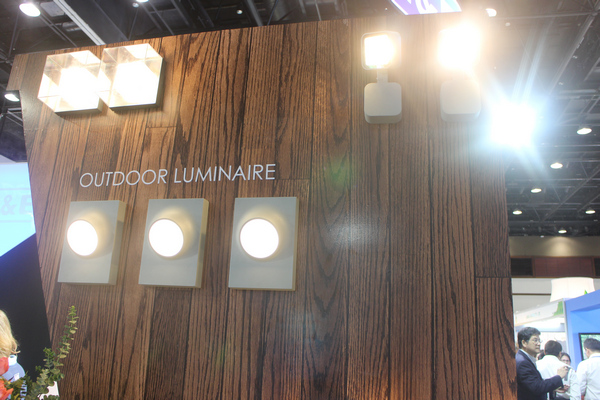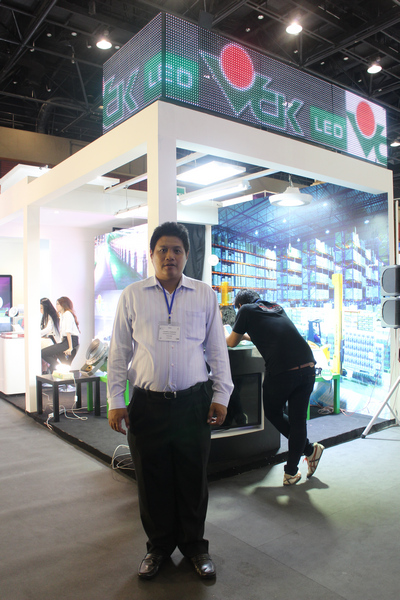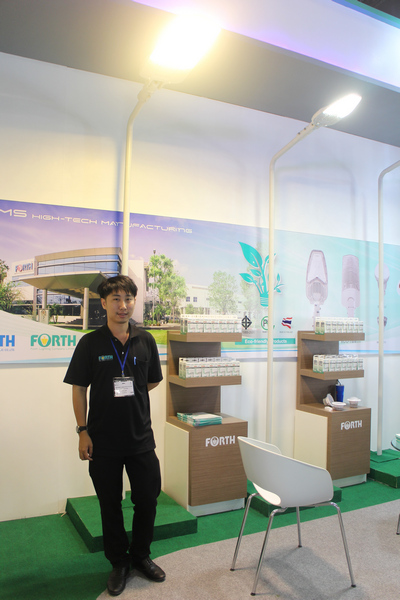The Thai LED market has emerged as a market holding great potential, government statistics estimate the current LED market value has reached 80 billion Thai baht (US $2.44 billion), said Dennis Stech, Vice President, of Hatari LED at EcoLightTech Asia 2014 in Bangkok, Thailand in mid-November. However, the country’s unstable political situation might lead to lower LED industry growth rates in 2015.
 |
|
L&E's retail lighting solution displayed at EcoLightTech Asia 2014. (LEDinside) |
Thai LED market growth
Compared to before 2014, when LED market share was only 5% in the Thai lighting industry, LED market share is expected to reach 70% by 2020, said Stech. LED lighting penetration rates in the Thai lighting market has reached an estimated 10% to 15%, said Vincent Chang, Manging Director, Glaring International. The LED industry has really picked up in 2013, observed Nathan kulvadhanaphan, Product Development Manager, Lumoz, AKE Enterprise.
 |
|
L&E's outdoor luminaire products. Thai government policies have driven down LED bulb prices. (LEDinside) |
The increasing LED lighting penetration rates are attributed to Electricity Generating Authority of Thailand (EGAT) subsidies that have lowered LED prices to US $4 to $5, said Pongskorn Ouvuthipong, LED Product Director, L&E. “Government subsidies continue to play a key role in the Thai LED market,” he added.
The Thai government projected LED market Compound Annual Growth Rate (CAGR) to reach 30% in the next five years, to bring the total market value from US $900 million to US $1 billion. LED manufacturers reported growth rates were consistent with Thai government estimations. The average growth rate reported by the nine manufacturers willing to reveal revenue statistics was about 34.67%. Some high performers even reported growth rates soared at least 50%.
|
LED manufacturer
|
Revenue growth rates in 2014 compared to 2013 (%)
|
Type of products
|
|
PEA Encom
|
60
|
LED bulbs
|
|
Opple
|
50
|
Residential lighting
|
|
Civic media
|
25
|
Smart LED display
|
|
Racer
|
20
|
Tube/Streetlights
|
|
T&T Innovation
|
40
|
LED driver, LED PCB, Streetlights
|
|
Unity Opto
|
20
|
LED tube lights, streetlights
|
|
L&E
|
47-48
|
LED tube, streetlight
|
|
Glaring
|
20
|
LED tube, bulb, streetlights
|
|
Lioris
|
30-40
|
LED tube
|
(Source: LEDinside)
Thailand’s unstable political situation hurting economic growth
Yet, Thailand’s unstable political situation and sluggish economic performance might slow down LED industry growth next year. On May 22, 2014, the Royal Thai Armed Forces led a coup d'état that dissolved the former government headed by Yingluck Shinawatra and senate. The country has been under military junta National Council for Peace and Order (NCPO) rule since.
 |
|
Chumpol Charupas, Deputy Managing Director, Business Development, Vichukorn Enterprise. (LEDinside) |
Streetlight and major government projects in Thailand have been delayed since the political turmoil from a pro-business government to military junta, observed Chumpol Charupas, Deputy Managing Director, Business Development, Vichukorn Enterprise. Thailand’s overall economic growth has plummeted from the projected GDP 6.2% to a mere GDP 2.62% in 2014. “There is basically no economic growth this year,” said Charupas.
 |
|
Commercial building lighting applications such as hotel lighting seen in this picture have declined because of recent political turmoil in Thailand (LEDinside) |
In the private sector business investors are also more cautious about investing in real estate and building construction projects, which could further hurt the LED commercial lighting applications in the local market. “Real estate and building lighting growth have been stagnant in the Thai market this year,” said Eric Ooi, Group Marketing Manager, Trade Link Media, which publishes architectural lighting magazine Southeast Asia Building. Most investors are speculating because of the uncertain political situation, with many even considering to invest in Myanmar or Cambodia instead, he added.
 |
|
Vincent Chang, Manging Director, Glaring International posing with company product. The Taiwanese LED manufacturers revenue in Thailand has been affected by the easing Thai economy. (LEDinside) |
Smaller LED manufacturers are already feeling the impact from the easing economic growth. Glaring International, which has been in the Thai LED market for six years, reported company revenue growth declined in 2014 compared to 2013, said Chang. There has been a decline in large project demands, he added.
 |
|
Henry Ong, Marketing Director of Vestaronics, a distributor of MiPower LED products has reported declining sales in the aftermath of Thailand's recent political turmoil. (LEDinside) |
A LED distributor noted the Thai economic situation has caused retail revenue to plummet 50%, noted Henry Ong, Marketing Director of Vestaronics, a distributor of MiPower LED products, adding Thailand’s largest real estate group Central Group’s decision to raise commercial rental rates by 30% has made operations even more challenging. Vestaronics, which relies on selling products through Thai department stores, and other shops is considering to sell through other retail channels to cope with the rising rents.
 |
|
Forth's LED streetlights are being used in certain government streetlight projects in Thailand. |
Slowdown in mega government projects will no doubt impact local Thai LED manufacturers. Provincial Electricity Authority (PEA) has been mainly promoting LED streetlight projects have benefited manufacturers including Forth, which reported LED streetlight projects contributed 6 million Thai baht worth of revenue in 2014. Easing government projects will no doubt hurt LED manufacturers that target government streetlight projects.
ASEAN agreement to present opportunities for manufacturers to expand presence in neighboring countries
Some manufacturers might emerge from Thailand’s murky economic situation with the launch of Association of Southeast Asian Nations agreement in 2015. For instance, L&E has plans of moving into the Vietnam, Myanmar, Philippines, Malaysia and Indonesian market next year, said Ouvuthipong. Unistar Opto also noted the agreement will give it opportunities to sell products to Vietnam, Philippines and Myanmar, but expected more Chinese manufacturers to compete in the Thai market, said Darin Charang, Sales Representative, Unistar Opto.
The continual political instability in Thailand and uncertain business investment conditions might pose a more challenging environment, and even declined revenue for some smaller LED vendors. Still some manufacturers such as Vestaronics project revenue growth in 2015 to reach at least 20%. Others might take advantage of the ASEAN agreement to expand in Southeast Asian markets and stimulate revenue growth.
(Author: Judy Lin, Chief Editor, LEDinside)





 CN
TW
EN
CN
TW
EN












